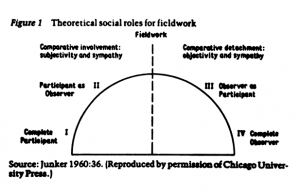Participant Observation
Participant observation is central to ethnography. It is the method by which the researcher both participates & observes in the studied environment.
The methodology of participant observation is exceptional for studying processes, relationships among people and events, the organization of people and events, continuities over time, and patterns, as well as the immediate sociocultural contexts in which human existence unfolds.
(Jorgenson, 1989; p12)
Participant observation entails spending time with research subjects in their ‘natural’ settings as they perform day-to-day activities, and getting involved in their daily lives.
The researcher observes behaviours, listens to comments and conversations of subjects, and engages in conversations and interviews and records this information as field notes for later analysis. Participant observation is:
- ‘holistic’ (aiming for a comprehensive picture)
- Contextualised (linking to the wider picture)
- ‘emic’ (understanding the views & interpretations of the researched)
The levels of participation/observation undertaken fluctuates and is on a continuum (ie you aren’t either ‘observing’ or ‘participating’ with no in between, you will perhaps do slightly more of one and less of the other at any given time). The continuum can be shown like so:
Most ethnographers will normally stay around the centre of the spectrum, as there are disadvantages both to becoming too attached to your participants, and by becoming too detached, although they offer different advantages in terms of the ability to contextualise findings more thoroughly through detailed field notes and make the familiar ‘strange’ (observer) and gaining a fuller understanding of the participants daily lives and perceived reality (participant). It is up to you to decide where you would like to sit on the spectrum at different times in your observation.
Reflexivity
Reflexivity whilst collecting data leads the researcher to examine their own place, biography, self and relation to the research subject, and how these issues shape the data collection and analysis.
Further Reading
Please see Jorgenson D (1989) The Methodology of Participant Observation, Sage Publications for a detailed overview of participant observation.


